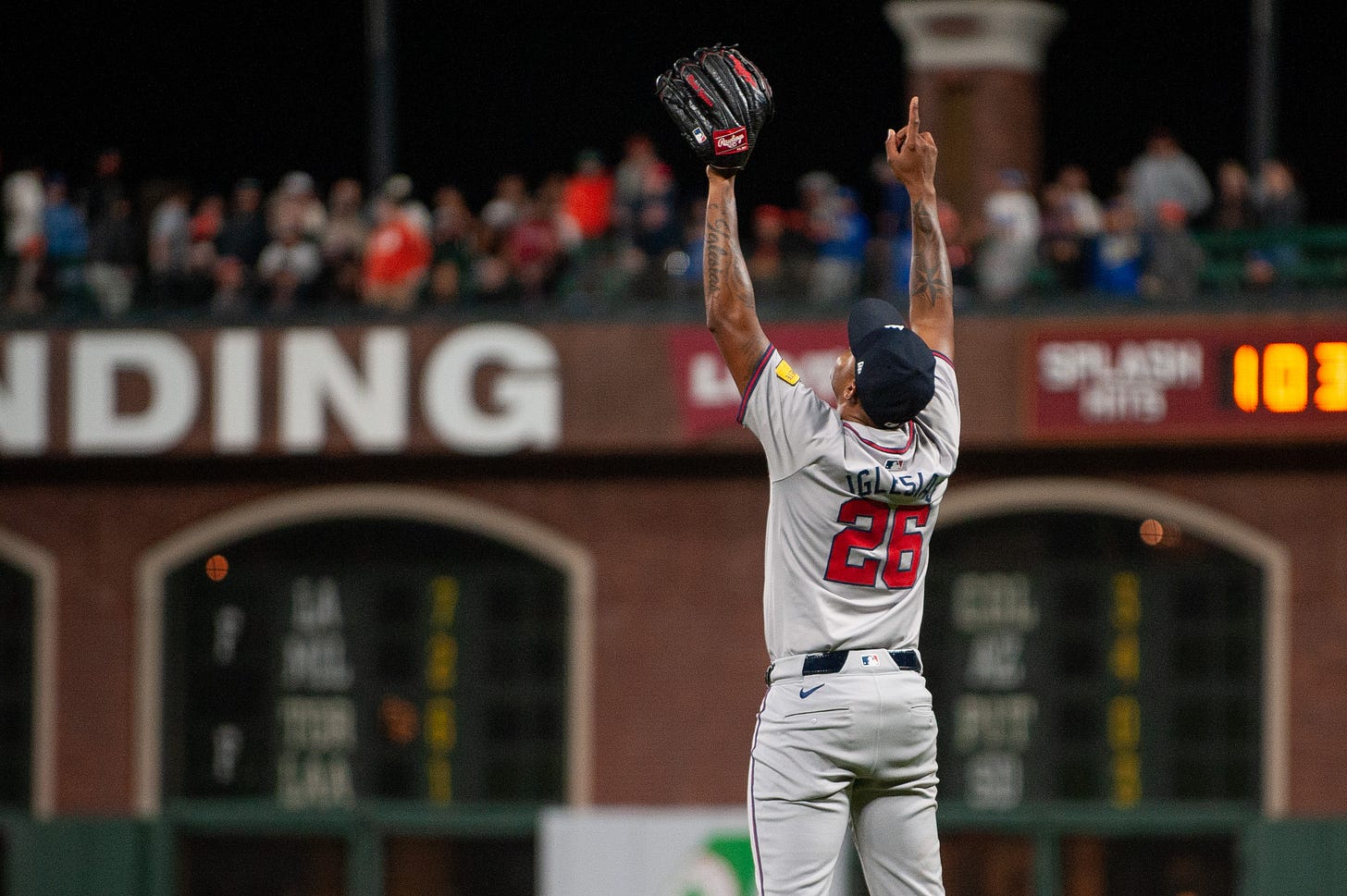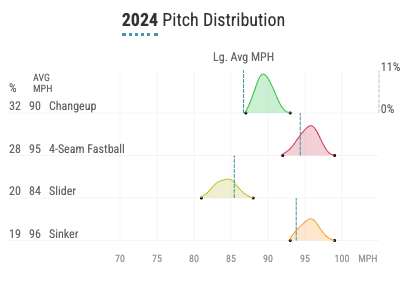How Raisel Iglesias Took His Game to the Next Level in 2024
The Atlanta Braves have one of the most underrated closers in all of MLB, but how did he take this leap from good to elite?
Among the lesser-discussed stories this season for the Atlanta Braves has been the dominance of their bullpen, specifically closer Raisel Iglesias.
Sure, there has been some national attention paid to it - he was the NL Reliever of the Month for August, after all, and there was some words written about his hidden “perfect game” - The righthander retired 39 consecutive batters in August, finishing the month with a 3-0 record, a 0.00 ERA, and an opponent batting average of just .071 with no walks and fourteen strikeouts.
I was asked last week on a radio appearance why Iglesias doesn’t get a ton of attention nationally and I think it’s because he doesn’t fit the common archetype of a modern closer. Think of the top closers in the game right now, like Emmanuel Clase, Jhoan Duran, and MLB saves leader Ryan Helsley. What do they have in common?
Absurd velocity.
Each of those three hurlers averages 100 mph or better on their primary fastball, with Helsley and Duran throwing a traditional four-seamer and Clase throwing a cutter.
Iglesias doesn’t fit that profile - his primary pitch is a firm changeup and his four-seam fastball averages ‘just’ 95.4 mph.
But what if I told you the fastball’s improvement is the key to Iglesias’s 2024 surge?
He’s not throwing it harder, but it’s performing much better
2023 wasn’t a bad year for Iglesias, according to the stats: 5-4 record, 33 saves (in 37 opportunities), and a 2.75 ERA.
But as we’ve talked about before, ERA can be misleading and pitcher wins aren’t a real stat.
Iglesias got bailed out a bit by his defense, with his Fielding Independent Pitching (FIP) coming in at 3.26 and his Expected ERA (xERA) coming in at 3.16. He allowed too much hard contact, with an average exit velocity of 88.8 mph (55th percentile among all pitchers) and a good but not great barrel rate of 6.8%, 71st percentile.
Most of those issues came back to the heater - the four-seamer was one of the worst fastballs in baseball last season, coming in at a -10 Run Value (12th percentile) after opponents hit .327 with a .558 slugging (and a .602 xSLG) off the pitch.
But in 2024? a .140 BAA and a .263 slugging, leading to a 93rd percentile +13 Run Value on the pitch. (All stats were entering Sunday’s action)
His lesser-used sinker saw an even larger improvement, going from a .519 BAA and .704 slug to a .091 BAA and .091 slug - in 156 thrown this season, he’s allowed exactly three hits, all singles.
The four-seam is not being thrown significantly harder - his 2023 average FB velocity was 95.0 and this year is 95.4.
So what is making the fastball perform so much better?
Is it the locations?
These differences don’t look like much, but bear with me here.
Here’s 2023:
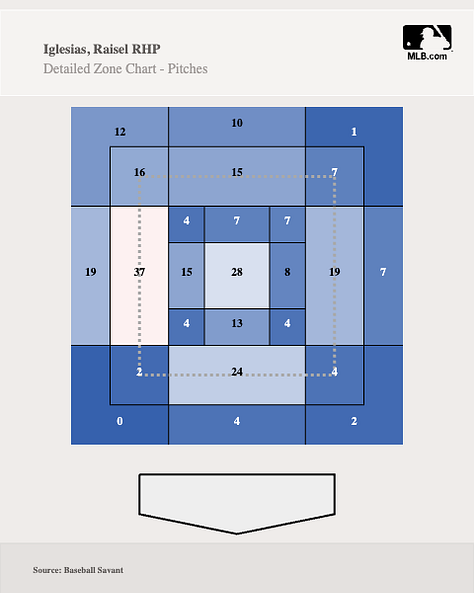
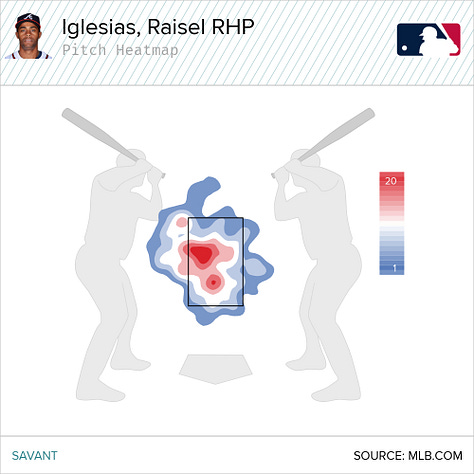
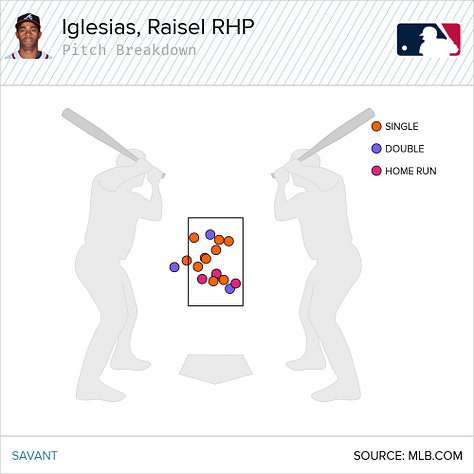
And here’s 2024:
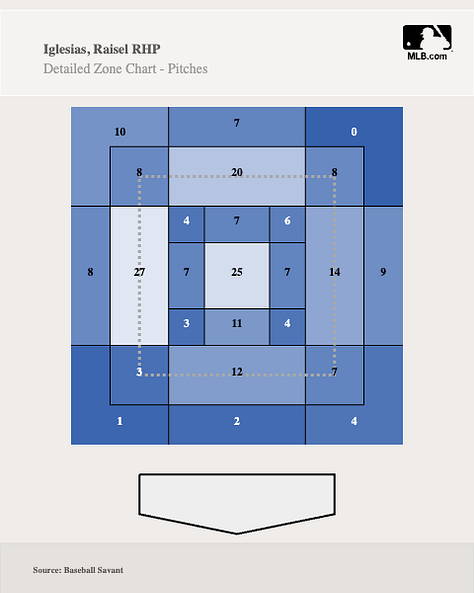
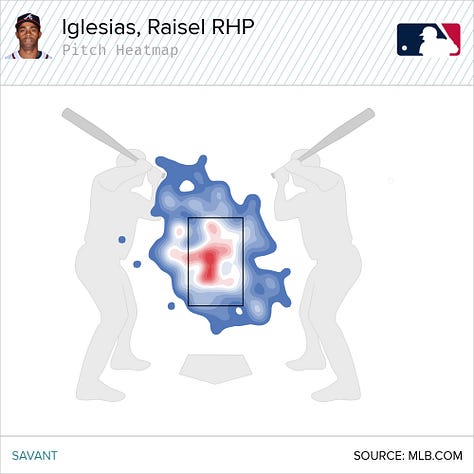
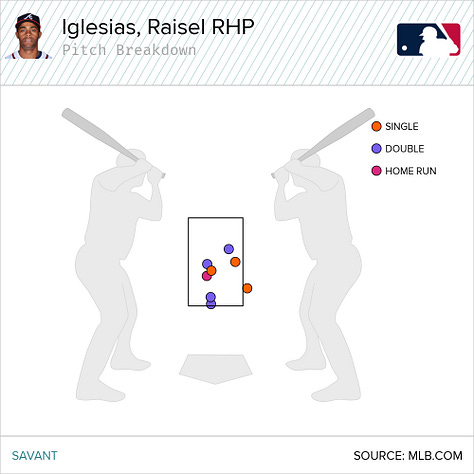
The heatmap is mostly the same, but the results are significantly different.
18.9% of his 2023 pitches were in-zone fastballs and they allowed a .400 batting average and .444 wOBA. He picked up just five strikeouts and 22 whiffs on in-zone heaters despite throwing 109 of them.
But in 2024? So far, only 16% of his pitches are in-zone fastballs and they’re allowing a .174 BAA and .216 wOBA. He’s already logged 12 strikeouts and 19 whiffs on just 81 swings.
So, is it these locations? Let’s look at it side by side:
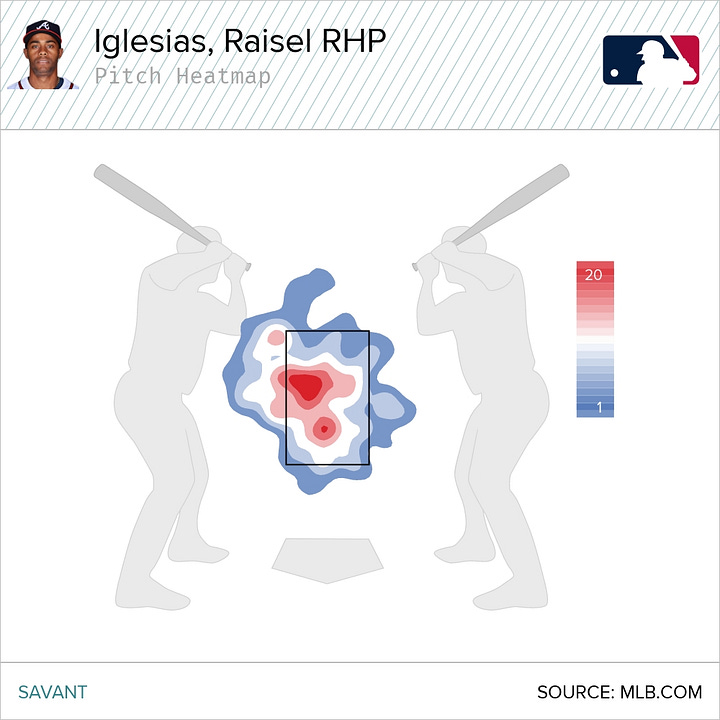
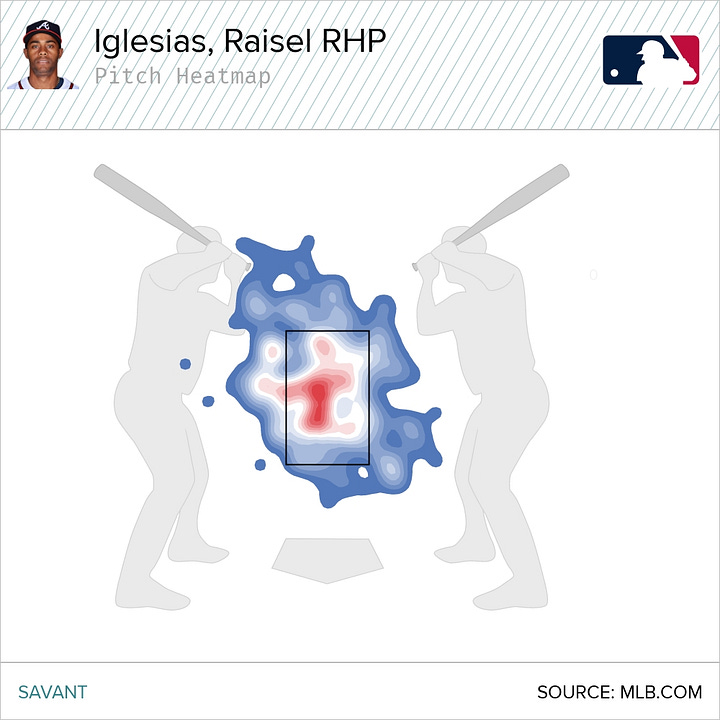
He’s in the zone close to the same amount, although when he leaves it up in 2024, it’s more middle-middle than inner-third to righties (these heatmaps are from the perspective of the catcher) like it was last year.
Is that it? Throwing fastballs right down the middle feels like it would actually RAISE opposing batting averages, not lower them, especially if they’re not being thrown noticeably harder. Maybe this is offset by being slightly less in the zone overall?
No, it’s gotta be something else.
WHEN Iglesias is throwing fastballs is the key
“Iggy” has always been good at getting ahead of hitters early - his most common count (after 0-0, obviously) has consistently been 0-1. But HOW he gets ahead of batters early is what’s changed this season.
After using 102 4S fastballs to open at-bats last season, he’s done that just 72 times in 2024. But the sinker, which opened just 60 at-bats last season, is already at 72 this year and the slider’s gone from 37 to 44. (The slider usage is up 5% overall, with a good portion of it being early in the at-bat.)
Combined, it adds up to a 10.67% reduction in fastball usage to open at-bats.
If he’s only throwing fastballs 4% less this year overall, where are the other fastballs going?
They’re being used when he’s ahead.
Iglesias has thrown 75 fastballs when ahead in the count this season, the 2nd-most used pitch for him in those situations, just behind the changeup. He totaled just 61 fastballs while ahead last season.
(And to answer the question - yes he’s been ahead of more batters this season but the percentages are still greater, with 7% of 2023’s total pitches being fastballs while ahead and 9.4% of this season’s pitches being fastballs while ahead.)
The early fastball usage is still a minor issue - the only hits off of Iggy’s fastball have come on 0-0, 0-1, and 1-1 counts this year - but it’s still better than last season when overuse early led to the fastball having a .364 BAA to open at-bats.
And yes, the increased slider usage has led to a slight reduction in effectiveness, from a +7 Run Value to a +3 Run Value (although still some nice above-average results, 69th percentile), but it’s a worthwhile tradeoff for the significantly improved fastball results.
But overall, the change to more sliders and sinkers early has been beneficial, not only in results but in the overall course of the at-bat. Iglesias has only been in a 3-0 count three times this season (with two of those in the same game). The at-bat resulted in an out in two of those three situations, with Iglesias throwing a fastball all three times he was down 3-0. Last season it happened nine times, resulting in five walks, a single, and three outs, with the fastball (5) and sinker (4) doing almost equal work in the 3-0 situation.
Luck plays a role, as well
Let’s not discount the role of luck here (or random variance, if you want to be more detailed). Iglesias had a BABIP of .312 last season, contributing to the xERA and FIP underperformance we discussed earlier.
This year? A .182 BABIP, meaning that he’s currently overperforming his FIP by almost a full run (FIP of 2.21 vs ERA of 1.22) and his xERA by 90 points (1.22 ERA vs 2.12 xERA).
It’s probably some of everything
If we’re being honest, these are all somewhat small sample sizes here. Iglesias has faced 215 batters this season and has thrown 796 pitches - a meaningful sample, to be sure, but not the absolute end-all, be-all. That’s the problem with relievers - one egregiously good or bad outing can skew the numbers a bit.
But it’s clear that Iglesias continues to tweak what he does and is becoming more, not less, successful as he gets into his mid-30s. He’s signed for one more season at $16M before hitting free agency after 2025, and it looks like the Braves might actually have a bargain there.




